| Revision as of 13:09, 23 August 2024 editOhnoitsjamie (talk | contribs)Edit filter managers, Autopatrolled, Administrators261,178 editsm Reverted edit by BenWelkins (talk) to last version by RodRabelo7Tag: Rollback← Previous edit | Revision as of 00:35, 13 September 2024 edit undo103.129.191.109 (talk) →External linksTag: RevertedNext edit → | ||
| Line 249: | Line 249: | ||
| ==External links== | ==External links== | ||
| Commons category|Thua Thien Hue | |||
| Official website|http://www.thuathienhue.gov.vn/ | |||
| ⚫ | |Centre = Thừa Thiên Huế | ||
| |province = | |||
| {{Geographic location | |||
| ⚫ | |Centre = Thừa Thiên Huế |
||
| |North = | |North = | ||
| |Northeast = | |||
| |Northeast = '']''<br />], {{flag|China}} | |||
| |East = | |East = | ||
| |Southeast = ] | |Southeast = ] | ||
| |South = ] | |South = ] | ||
| |Southwest = ] |
|Southwest = ] | ||
| |] | |||
| |West = | |West = | ||
| |Northwest = ] | |Northwest = ] | ||
| }} | |||
| {{Subdivisions of Vietnam}} | {{Subdivisions of Vietnam}} | ||
| {{Authority control}} | {{Authority control}} | ||
| DEFAULTSORT:Thua Thien-Hue Province | |||
| ] | ] | ||
| ] | ] | ||
Revision as of 00:35, 13 September 2024
Province of Vietnam For the empress of the Nguyễn Dynasty, see Thừa Thiên (empress).| This article needs additional citations for verification. Please help improve this article by adding citations to reliable sources. Unsourced material may be challenged and removed. Find sources: "Huế" – news · newspapers · books · scholar · JSTOR (April 2012) (Learn how and when to remove this message) |
| Thừa Thiên Huế province Tỉnh Thừa Thiên Huế | |
|---|---|
| Province | |
     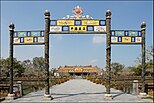 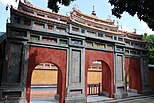 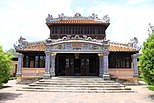   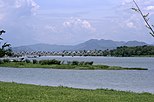  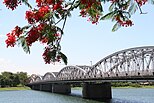  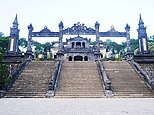 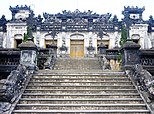 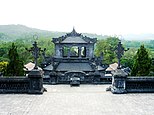    Imperial City of Huế • Hương River • Trường Tiền Bridge • Tomb of Khải Định • Lăng Cô Beach Imperial City of Huế • Hương River • Trường Tiền Bridge • Tomb of Khải Định • Lăng Cô Beach | |
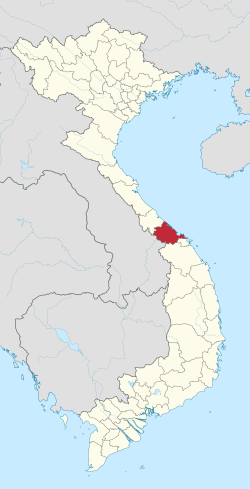 Location of Thừa Thiên Huế within Vietnam Location of Thừa Thiên Huế within Vietnam | |
| Coordinates: 16°20′N 107°35′E / 16.333°N 107.583°E / 16.333; 107.583 | |
| Country | |
| Region | North Central Coast |
| Capital | Huế |
| Government | |
| • People's Council Chair | Lê Trường Lưu |
| • People's Committee Chair | Nguyễn Văn Phương |
| Area | |
| • Province | 4,947.11 km (1,910.09 sq mi) |
| Population | |
| • Province | 1,160,200 |
| • Density | 230/km (610/sq mi) |
| • Urban | 612,800 |
| • Rural | 547,400 |
| Demographics | |
| • Ethnicities | Vietnamese, Chăm, Tà Ôi, Cơ Tu, Bru, Thai |
| GDP | |
| • Total | VND 47.428 trillion US$ 2.060 billion |
| Time zone | UTC+7 (ICT) |
| Postal code | 49xxx |
| Area codes | 234 |
| ISO 3166 code | VN-26 |
| HDI (2012) | 0.735 |
| Website | thuathienhue |
Thừa Thiên Huế (Vietnamese: [tʰɨə˨˩ tʰiən˧˧ hwe˧˦] ) is a southernmost coastal province in the North Central Coast region, the Central of Vietnam, approximately in the center of the country. It borders Quảng Trị to the north, Quảng Nam and Đà Nẵng to the south, Salavan of Laos to the west and the East Sea to the east.
Thừa Thiên Huế has 128 km of coastline, 22,000 ha of lagoons and over 200,000 ha of forest. There is an extensive complex of imperial tombs and temples in Huế. The province is widely called Xứ Huế (The Land of Hue).
Thừa Thiên Huế is located in the middle of North Central and South Central (including the South Central Coast and Central Hightlands) as a transition in many aspects: geology, climate, administrative division and local culture.
History
The region's history dates back some 20,800 years according to archaeological findings from the Sa Huynh Culture as well as from relics in the region. Đại Việt became an independent nation around 938 AD of which territorial conflict lasts for about four centuries between the Đại Việt and the Champa. The two provinces then changed their names to Thanh and Hóa. In 1307, Đoàn Nhữ Hài was appointed by the emperor, Trần Anh Tông, to administer the area. The people from the north (Thanh Hóa) migrated south and integrated with the people of the Kingdom of Champa. During this time, had the settlement of Hoa Chau province began, which included the area of present-day Thừa Thiên.
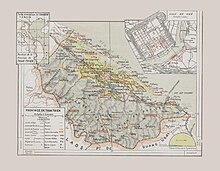
Between the settlement of Thuận Hóa (1306) to the founding of Phú Xuân (1687), there were conflicts and uncertainties for the local people, which including the fall of the Trần Dynasty to the renaissance of the Hồ dynasty. Thuận Hóa and Phú Xuân became the location of the Đại Việt kingdom once Nguyễn Hoàng was appointed head of Thuận Hóa (1511–1558). Lord Nguyễn Hoàng (1558–1613) established bases at Ai Tu, Tra Bat and Dinh Cat, while his lords moved palaces to Kim Long [vi] (1636), where they would eventually base their operations in Phú Xuân (1687). The Nguyễn lords ruled the area until it tookn over the Trinh clan in 1775. The farmers' movement led by the Tây Sơn brothers gained momentum in 1771. The Tây Sơn insurgent army won the battle in Phú Xuân to take over the Nguyễn capital in 1786, where they continued north and overthrew the Trinh Dynasty. In Phú Xuân, Nguyễn Huệ appointed himself king, and with internal differences with the Tây Sơn Movement and the death of Nguyễn Huệ (1792), Nguyễn Ánh took advantage of the situation and took over Gia Định with the support of foreign forces. Nguyễn Ánh attached to the Tây Sơn movement and took over Phú Xuân and the throne, thereby choosing the dynasty title of Gia Long (1802). Phú Xuân was again chosen as the capital of Vietnam until 1945's August Revolution. Prior to 1975, the province was known simply as Thừa Thiên.
The province is known as an area of heavy fighting during the Vietnam War, as it was the second-most northerly province of the South Vietnam, close to the North Vietnamese border (DMZ) at the 17th parallel. More U.S. soldiers died in this province than in any other province in Vietnam (2,893). The Massacre at Huế occurred here; an estimated 2,800 to 6,000 civilians and Army of the Republic of Vietnam (ARVN) prisoners of war (POWs) were slaughtered by the Việt Cộng. Thừa Thiên Huế province saw a large influx of North Vietnamese settlers soon after the Vietnam War ended, as with the rest of the former South. This province and neighbouring Quảng Nam province suffered greatly from flooding in November 1999.
Geography
The Perfume River (called Sông Hương or Hương Giang in Vietnamese) passes through the center of province. The province also accommodates the Tam Giang–Cau Hai lagoon, the largest lagoon in Southeast Asia, which is 68 kilometres (42 mi) long with a surface area of 220 square kilometres (85 sq mi). The province comprises four different zones: a mountainous area, hills, plains and lagoons separated from the sea by sandbanks. It has 128 kilometres (80 mi) of beaches. The mountains, covering more than half the total surface of the province, are along the west and southwest border of the province, their height varying from 500 metres (1,600 ft) to 1,480 metres (4,860 ft). The hills are lower, between 20 metres (66 ft) and 200 metres (660 ft), with some points at 400 metres (1,300 ft), and occupy about a third of the province's area, between the mountains and the plains. The plains account for about a tenth of the surface area, with a height of only up to 20 metres (66 ft) above sea level. Between the hills are the lagoons which occupy the remaining five per cent of the province's surface area.
Bạch Mã National Park is a protected area near the city of Hué. It covers 220 square kilometres (85 sq mi) and comprises three zones: a strictly protected core area, an administrative area and a buffer zone. The climate is similar to central Vietnam in general: a tropical monsoon climate. In the plains and in the hills, the average annual temperature is 25 °C (77 °F), but in the mountains only 21 °C (70 °F) (statistical yearbook 2004). The cool season is from November to March with cold northeasterly winds. The lowest average monthly temperature is in January: 20 °C (68 °F). In the cool season temperatures can fall to 12 °C (54 °F) in the plains and the relative humidity is high, between 85 and 95 per cent. Then follows a warmer period from April to September with average monthly temperatures up to 29 °C (84 °F) in July, reaching up to 41 °C (106 °F) at times. It is very humid in July but relative humidity is lower, sometimes down to 50 per cent.
The annual precipitation in the province is 3,200 millimetres (130 in) but there are important variations. Depending on the year the annual average may be 2,500 millimetres (98 in) to 3,500 millimetres (140 in) in the plains and 3,000 millimetres (120 in) to 4,500 millimetres (180 in) in the mountains. In some years the rainfall may be much higher and reach more than 5,000 millimetres (200 in) in the mountains. The rainy season is from September to December—about 70 per cent of the precipitation occurring in those months. Rainfall often occurs in short heavy bursts which can cause flooding and erosion, with serious social, economic and environmental consequences. The floods of November 1999 led to 600 deaths and affected 600,000 homes. (Comité des inondations, 1999).
Flora and fauna
A remote region known as the "Green Corridor" is home to many species. New species of snake, butterfly, and orchid have been found there in 2005 and 2006, as stated by Chris Dickinson of the World Wide Fund for Nature (WWF) on 26 September 2007. The scientists discovered 11 new species of plants and animals, including a snake, two butterflies and five leafless orchid varieties. The new snake species is a white-lipped keelback (Hebius leucomystax). The new butterfly species are a skipper from the genus Zela and the other from Satyrinae. The new plant species also include one in the genus Aspidistra, and a poisonous Arum perennial.
Administrative divisions
Thừa Thiên Huế is subdivided into 9 district-level sub-divisions:
- 6 districts:
- 2 district-level towns:
- 1 provincial city:
- Huế (capital)
They are further subdivided into 8 commune-level towns (or townlets), 105 communes, and 39 wards.
Demographics
| This section needs expansion. You can help by adding to it. (June 2008) |
The average population of the province is 1.143.572, which consist of approximately 567.253 males and 576.319 females. The rural population is approximately 587.516 while the urban population is 556.056 (2015).
| Largest cities or townships in Thừa Thiên Huế province (2015) | ||||
|---|---|---|---|---|
| Rank | Name | Type | District | Population |
| 1 | Huế | City | 354,124 | |
| 2 | Hương Trà | Town | 116,147 | |
| 3 | Hương Thủy | Town | 101,353 | |
| 4 | Thuận An | Township | Phú Vang district | 21,220 |
| 5 | Phú Đa | Township | Phú Vang district | 12,381 |
| 6 | Lăng Cô | Township | Phú Lộc district | 12,177 |
| 7 | Phú Lộc | Township | Phú Lộc district | 10,613 |
| 8 | Sịa | Township | Quảng Điền district | 10,583 |
| 9 | A Lưới | Township | A Lưới district | 7,393 |
| 10 | Phong Điền | Township | Phong Điền district | 6,743 |
| 11 | Khe Tre | Township | Nam Đông district | 3,818 |
Economy
The retail sales of goods and services (trade, hotel, restaurant, tourism) in the province is 10960.6 billion đồng or 0.9 percent of the country. This is compared with 12.7 percent for Hanoi and 23.5 percent for Ho Chi Minh City (2009). The province has more than 120 km of coastline, which provides for a seafood industry that produces over 40,000 tonnes/year consisting of over 500 species of fish.
There are more than 100 mines for minerals and non-mineral resources with the majority consisting of limestone, granite and kaolin. Arts (e.g. wood works, fabrics, furnitures, paper arts, pottery), literature (text books), and spicy cuisines (included dry goods, vegetarian food) are the main exports of this region. Exquisite custom-made áo dài (Vietnamese long dress), and nón lá (conical hat) are souvenir items for foreign visitors and overseas Vietnamese. The ability to make toys, design lanterns, form special papers, and figurine-making are native skills. Such fruits as rambutan, jackfruit, lychee, durian, dao, dragon fruit, star fruit, mangosteen, coconut, and kumquat are grown in this area due to sufficient amount of rain received each year.
Many historical buildings are located in Huế, largely a legacy from its time as a capital of the Nguyễn dynasty (1802–1945), including the Royal Citadel, the Flag Tower, the Royal Palace, and the Royal Tombs. Huế's Forbidden Purple City was once reserved for the royal family, but was severely damaged during the Vietnam War. Outside the city is the religious site known as Nam Giao Hill ("Heaven's Altar"). Hue Brewery Ltd is located on Hương Giang in Huế with a recognizable brand in central Vietnam. The Brewery is jointed owned by the state and private sector and was founded in 1990 with an initial investment of US$2.4 million with a capacity of 3 million liters/year, which has grown to a capacity of 100 million liters/year in 2007.
Transportation
Vietnam's National Route 1, which runs the entire length of the nation from north to south, passes through Huế. Huế and Đà Nẵng are the main intermediate stops on the railway line from Hanoi to Ho Chi Minh City. This province is served by two sea ports: Thuan An Port and Chân Mây Port. Phu Bai International Airport, the largest domestic airport in terms of passengers per year is situated 15 km south of Huế. This airport ranks fourth among Vietnam's airports. The government has approved the upgrade of this airport to an international airport with some air links inside Asia.
Education
| This section needs expansion. You can help by adding to it. (June 2008) |
This province is home to Huế University (e.g.: Huế Economic University, Huế Medicine University, Huế Pedagogical University, Huế Forestry and Agriculture University, Huế University of Sciences, Huế University of Arts, Huế Conservatory of Music and Huế College of Foreign Languages). As of 2009 the province had 190 schools, 1302 classrooms, 2184 teachers and 36,200 pupils.
The most famous high school in Thua Thien Hue province is Quốc Học – Huế High School for the Gifted. It is well known for its high quality of education. Besides, its reputation comes from its ancient structure of France.
International relations
Sister cities
Thừa Thiên Huế is twinned with:
 Bandar-e Anzali, Gilan province, Iran
Bandar-e Anzali, Gilan province, Iran Blois, Centre-Val de Loire, France
Blois, Centre-Val de Loire, France
 Honolulu, Hawaii, United States''
Honolulu, Hawaii, United States''
 New Haven, Connecticut, United States''
New Haven, Connecticut, United States''
 Phra Nakhon Si Ayutthaya, Thailand
Phra Nakhon Si Ayutthaya, Thailand
 Quebec, Canada
Quebec, Canada
 Rennes, Brittany, France
Rennes, Brittany, France
 Yogyakarta, Java, Indonesia
Yogyakarta, Java, Indonesia
Notable residents
- Thích Nhất Hạnh, Buddhist monk
- Trịnh Công Sơn, composer
- Ngô Viết Thụ, architect
- Ho Ngoc Ha, singer and actress
Etymology
The province's name derives from Sino-Vietnamese 承天順化.
References
- Biểu số 4.3: Hiện trạng sử dụng đất vùng Bắc Trung Bộ và Duyên hải miền Trung năm 2022 [Table 4.3: Current land use status in the North Central and South Central Coast regions in 2022] (PDF) (Decision 3048/QĐ-BTNMT) (in Vietnamese). Ministry of Natural Resources and Environment (Vietnam). 18 October 2023. – the data in the report are in hectares, rounded to integers
- ^ General Statistics Office of Vietnam (2023). Statistical Yearbook of Vietnam 2022 (PDF). Statistical Publishing House (Vietnam). ISBN 978-604-75-2429-7.
- "Tình hình kinh tế, xã hội Thừa Thiên - Huế năm 2018". Cổng thông tin điện tử tỉnh Thừa Thiên - Huế. Retrieved 10 May 2020.
- "Growth that works for all: Viet Nam Human Development Report 2015 on Inclusive Growth" (PDF). United Nations Development Programme. January 2016. pp. 173–174. Archived from the original (PDF) on 31 August 2018. Retrieved 31 August 2018.
- "Thua Thien Hue some facts on historical establishment and development". Thừa Thiên Huế province government website. Archived from the original on 3 October 2011. Retrieved 26 September 2011.
- http://www.rjsmith.com/kia_tbl.html" Archived 2010-04-15 at the Wayback Machine
- ^ Atlas des lagunes de Thừa Thiên Huế, 2003
- Villegas 2004
- Villegas, Piero (2004). "Flood modelling in Perfume river basin, Hue province, Vietnam" (PDF).
{{cite journal}}: Cite journal requires|journal=(help) - Integrated Management of Lagoon Activities Project - an FAO sustainable lagoon management project in the province.
- Recent news release by WWF
- The Green Corridor Project Archived 2007-09-15 at the Wayback Machine - a WWF conservation endeavor located in the province.
- "Yahoo.com, Scientists find new species in Vietnam".
- "Districts & Hue City". About Government / Administrative system. ThuaThienHue province. Retrieved 16 November 2011.
- "Population and Employment". Monthly Statistical Information. General Statistics Office of Vietnam. Retrieved 16 November 2011.
- "Retail sales of goods and services at current prices by province". Statistical Data. General Statistics Office of Vietnam. Retrieved 16 November 2011.
- "Potentials and perspective". About Thừa Thiên Huế Province. Thừa Thiên Huế Portal. Retrieved 16 November 2011.
- "Geographical conditions and natural resources". About Thừa Thiên Huế Province. Thừa Thiên Huế Portal. Archived from the original on 31 March 2012. Retrieved 16 November 2011.
- "About Us". Hue Brewery Ltd. Retrieved 16 November 2011.
- "General Statistics Office Of Vietnam". Gso.gov.vn. 13 August 2010. Retrieved 13 August 2012.
- "شهرهای بندر انزلی و هوء در ویتنام خواهر خوانده شدند". www.aftabir.com (in Persian). aftabir. 19 July 2004. Archived from the original on 19 August 2019. Retrieved 17 December 2016.
- "Jumelages et coopérations" (in French). Retrieved 20 February 2017.
- ^ "Hue, Vietnam". Sister Cities International. Archived from the original on 23 March 2014. Retrieved 22 March 2014.
- Chicha (23 May 2013). "บ้านพี่เมืองน้อง อยุธยา-เมืองกุม" [Sister City 'Ayutthaya-Muang Kum'] (in Thai). bangkokbiznews.com.
External links
Commons category|Thua Thien Hue Official website|http://www.thuathienhue.gov.vn/ |Centre = Thừa Thiên Huế |province = |North = |Northeast = |East = |Southeast = Da Nang |South = Quảng Nam province |Southwest = Salavan province |Sekong province |West = |Northwest = Quảng Trị province
| Subdivisions of Vietnam | |||||||||||||||||
|---|---|---|---|---|---|---|---|---|---|---|---|---|---|---|---|---|---|
| Municipalities |
| ||||||||||||||||
| Provinces |
| ||||||||||||||||
DEFAULTSORT:Thua Thien-Hue Province
Categories: